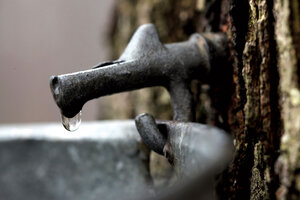‘We ring in the spring together’: Sharing the secrets of maple sugaring

Maple sap drips from an old-style metal spile into a bucket in Alexander, New York.
David Duprey/AP/File
We check weather reports four times a day. Snowdrops have been flowering for a week, the aconite about to burst.
The texting begins.
We meet on a Sunday. We come from nearby: an eclectic group of people with different backgrounds and political beliefs, the kind of group we hear doesn’t exist much anymore. We’re as young as 3 and as old as a couple celebrating their 50th wedding anniversary this year. We wear hiking boots, sometimes metal spikes if the ice is bad. The sugar maples love hard-to-get-to ridges and ravines.
Why We Wrote This
A diverse community united in common purpose is privileged and strengthened – even in so rural and timeless a task as gathering maple sap to boil into syrup.
There’s Randy, the doyen of the enterprise. It’s his sugarhouse, his buckets, lids, and spiles, his truck. Most important, it’s his lifetime of knowledge. He tells stories of maple sugaring as a kid and rival sugar gangs making it look as though one of the other gang leaders tapped a telephone pole.
There’s Bill, who, after Randy drills the hole into the tree, lightly hammers in the plastic spile, or spout. Lynn, his wife, makes dynamite venison burgers we’ll eat by the fire. Ralph makes a mean ham and bean soup that accompanies the biggest collection day. His wife, Robin, made the bags for carrying pails and lids so we have free hands to steady ourselves in the woods. Tom, the expert welder, kept the old evaporator limping along for years. His wife, Sally, is a reverend who blesses our operation out of earshot.
And there is Nan, Randy’s wife, who lets this whole thing go on, year after year, from late winter into dawning spring. She tolerates mud from our cars and boots, the glowing sugar shack in the deep night. The rest of us are mostly younger, some of us children and grandchildren of the “originals,” some of us simply neighbors who had the good fortune of moving to this rural road. We’ve been at it long enough to pretend to be full of our own stories. We ask a lot of questions that the originals mostly answer, sometimes even honestly. We retell the story of finding the unfortunate dead flying squirrel in one of the buckets as if it were our own.
“Why is this better than anything else?” Bill asks. I say I don’t know, but I try to explain it to myself every year. Perhaps it’s that the running sap signals winter’s long hibernation is drawing to a close, and exploding spring is about to pounce. It’s that we get to use our legs and hands, head and heart. We tramp our land and our neighbors’ land, sharing in this rich bounty of maple trees.
Back at the sugarhouse, we share homemade cider or donuts. We watch steam rise and smell fine sugared air. The sun lingers longer, radiating a strengthening warmth on our dark vests and jackets. Once the sun has set, we all move inside the little shack, congregating around the evaporator, harassing whoever built up the fire too high or not high enough. The occasional drop of condensation hits our skin, a kind of baptism, as we ring in the spring together.
For some in the maple syrup business, it’s now a high tech, high stakes operation made more precarious by climate change. The Monitor’s director of photography, Alfredo Sosa, recently visited syrup-makers in Vermont. Watch the video below for their story.


